


Magnet basics
The Care and Feeding of your Magnet
How do you take proper care of your permanent
magnet?
There are only four areas you need to be concerned with:
a. Mechanical Shock
b. Heat
c. Moisture
d. Demagnetizing Fields
Depending on the class of magnet you have, the care will vary slightly.
(Kind of like taking care of your pet fish!)
Ceramic or Ferrite Magnets
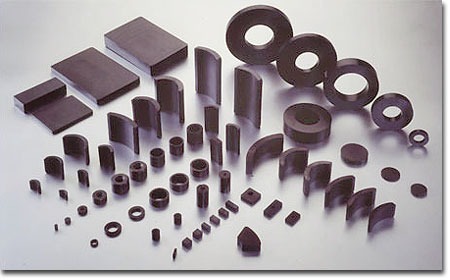
These are the magnets you usually see everywhere - on your fridge, in hooks to hold something, in your shower curtain, in your audio speakers, etc. They are usually black or dark gray in color, but the surface may be painted any bright color. These also include the flexible magnets since the flexible binder has magnetized ferrite material in it.
a. Mechanical Shock
These magnets are brittle - they will chip or crack or break easily when:
dropped onto
a hard surface
allowed to
smash together with another magnet
allowed to
smash together with a piece of metal
struck with a
hammer or other hard substance
So, handle gently, like you do with your iPod or cell phone. When you bring two magnets together, be prepared to have the force of attraction increase quickly and dramatically as the North pole of one gets closer to the South pole of the other. Better still, place a plastic disk or rubber washer between them so there is a cushion between them. Watch your fingers so they don't get pinched!
You may not realize it, but every particle within a magnet wants to push away from every other particle next to it. Yes, it is attracted to the particle at its North end and South end, but all along its sides, there is a repulsion. Because of this, if two magnets are allowed to smash together, expect a small chip or particle to fly away at a high velocity and can fly into your eye. That is why it's a good thing to wear goggles - protect your eyes from the unexpected. Those particles have sharp edges and will easily scratch your eyes.
b. Heat
As the temperature increases, the molecules that make up the magnetic
material, with their poles all lined up, will start to wiggle and jiggle around,
causing the strength of the magnet to decrease. If allowed to go above
their maximum working temperature, they will lose some of their strength and
will not be able to recover it when it cools back down. If allowed to go
above their Curie Temperature, they will lose all of their magnetic strength and
will not be able to recover from it.
For ceramic and ferrite magnets, their
maximum working temperature is 300 degrees C (572 degrees F).
The maximum working temperature for flexible magnets is about 180C (356F).
The Curie Temperature for ceramic and ferrite
magnets is 460C (860F).
I'm not sure about flexible magnets since the binder starts melting around 200C
(392F).
Instead, keep your magnets cool.
c. Moisture
Ferrite magnets do not corrode or rust easily, so you don't have to worry
too much about them.
d. Demagnetizing Fields
Ceramic or ferrite magnets are fairly rugged regarding their resistance to
be demagnetized. This is true as long as you keep them away from rare
earth magnets. But when used with other ferrite magnets, there is little
chance of demagnetizing them, even if you store them with North and North poles
touching.
Alnico Magnets
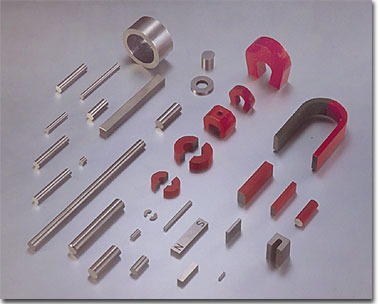
Alnico magnets are the magnets you usually play with at school, in horseshoe shapes and as bar magnets. They have a color like aluminum and are also usually painted red or black or left with its natural color.
a. Mechanical Shock
These magnets are very tough - they do not chip or crack or break
easily when:
dropped onto
a hard surface
allowed to
smash together with another alnico magnet
allowed to
smash together with a piece of metal
struck with a
hammer or other hard substance
You still have to be prepared to have the force of attraction increase quickly and dramatically as the North pole of one gets closer to the South pole of the other. Magnets made of alnico are usually cast in a mold and then magnetized.
b. Heat
Heat is another strength for alnico magnets.
Their maximum working temperature is 540
degrees C (1004 degrees F).
The Curie Temperature for alnico magnets is a blistering 860C (1580F).
Hot temperatures are not going to affect these magnets much!
c. Moisture
Again, with the aluminum and nickel mixed in the alloy with the iron, alnico
magnets are not prone to rusting or corroding. So they work great in tough
environments.
d. Demagnetizing Fields
The weakness of alnico magnets is that they can easily be
demagnetized - even with another alnico magnet. They don't last long when
you push two North poles together to feel the repulsion. After a while,
you will notice that they begin to weaken. The greatest care for these
magnets is in how you store them and restore them.
First, you don't want to bring ferrite or rare earth magnets close to alnico magnets. You can very quickly demagnetize them or remagnetize them in the opposite direction! How should they be stored?
If you have a horseshoe alnico magnet, store them with a keeper. This is just a steel bar that will stick to the two ends of the magnet. The purpose is to allow the field to continue flowing through the horseshoe and not be pushed around by other magnetic fields. The following diagrams show this. You could even place two horseshoes together, with opposite poles touching, to keep them strong.
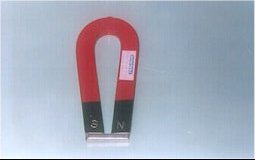
If you have bar magnets, they can be stored in pairs or back to back with opposite poles touching. Or, if you only have one, place it onto a steel sheet that would act like a big keeper. These diagrams show this.
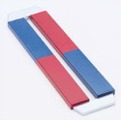
If and when they become weak, they can be restored using a remagnetizer. These are sold by Arbor Scientific and others. Check the page on magnet supplies. Inside of a remagnetizer are some very strong rare earth magnets that will re-align the domains in the alnico so that they will be as good as new again.
Samarium Cobalt Magnets
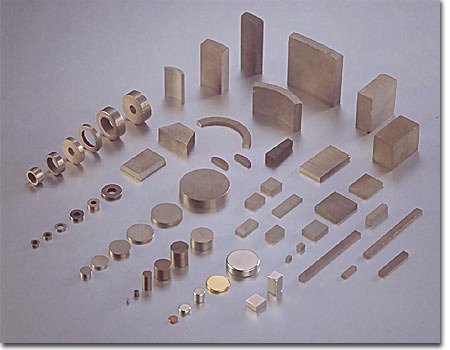
SmCo magnets are not seen very often. They are used in small motors for your VCR or your CD / DVD player. They are more expensive than the other magnets, but with a special set of strengths.
a. Mechanical Shock
These magnets are brittle - they will chip or crack or break easily when:
dropped onto
a hard surface
allowed to
smash together with another magnet
allowed to
smash together with a piece of metal
struck with a
hammer or other hard substance
So again, handle gently, like you do with your iPod or cell phone. When you bring two magnets together, be prepared to have the force of attraction increase quickly and dramatically as the North pole of one gets closer to the South pole of the other. Better still, place a plastic disk or rubber washer between them so there is a cushion between them. Watch your fingers so they don't get pinched!
You may not realize it, but every particle within a magnet wants to push away from every other particle next to it. Yes, it is attracted to the particle at its North end and South end, but all along its sides, there is a repulsion. Because of this, if two magnets are allowed to smash together, expect a small chip or particle to fly away at a high velocity and can fly into your eye. That is why it's a good thing to wear goggles - protect your eyes from the unexpected. Those particles have sharp edges and will easily scratch your eyes.
b. Heat
For a very strong magnet, these can handle a fair amount of heat.
Their maximum working temperature is 300
degrees C (572 degrees F).
The Curie Temperature for SmCo magnets is 750C (1382F).
Very respectable for a sintered magnet.
c. Moisture
Rust and corrosion from water is not a big factor with SmCo magnets.
They can survive in a fairly tough environment.
d. Demagnetizing Fields
About the only thing that can demagnetize a SmCo magnet is a NdFeB
magnet. So for storage, keep them separate from other classes of magnet
for two reasons: 1. they don't demagnetize other, weaker magnets and
2. so they aren't demagnetized by stronger magnets.
Neodymium-Iron-Boron Magnets

NdFeB magnets are the strongest permanent magnets around today, and are not very expensive. They are used in headphones, disk drives, new toys, all over the place.
a. Mechanical Shock
These magnets are brittle - they will chip or crack or break easily when:
dropped onto
a hard surface
allowed to
smash together with another magnet
allowed to
smash together with a piece of metal
struck with a
hammer or other hard substance
So again, handle gently, like you do with your iPod or cell phone. When you bring two magnets together, be prepared to have the force of attraction increase quickly and dramatically as the North pole of one gets closer to the South pole of the other. Better still, place a plastic disk or rubber washer between them so there is a cushion between them. Watch your fingers so they don't get pinched! Because these magnets are so much stronger than others, this needs to be a real precaution!
You may not realize it, but every particle within a magnet wants to push away from every other particle next to it. Yes, it is attracted to the particle at its North end and South end, but all along its sides, there is a repulsion. Because of this, if two magnets are allowed to smash together, expect a small chip or particle to fly away at a high velocity and can fly into your eye. That is why it's a good thing to wear goggles - protect your eyes from the unexpected. Those particles have sharp edges and will easily scratch your eyes.
b. Heat
This is the weakness of this magnet.
Their maximum working temperature is only 150
degrees C (302 degrees F).
The Curie Temperature for NdFeB magnets is 310C (590F).
This is why they usually aren't used in motors. Keep your magnets cool.
c. Moisture
This is another area of weakness. To combat the problem of these
magnets corroding so easily, they are usually coated or plated. A popular
plating material is zinc since it is cheap, but it isn't very good. A
better coating is nickel. This keeps them looking nice and shiny for a
long time. Some are coated with a very thin layer of gold over the
nickel. This is more for looks, but is also useful since gold does not
tarnish.
d. Demagnetizing Fields
This is an area where these magnets outperform others. They are tough
to demagnetize. This also means that they can easily demagnetize other
classes of magnets - like SmCo or Alnico or Ferrite! Again, store your
magnets separately by class.
Storage of Magnets
Basically, store different classes of magnets separately. Keep your ferrites together in one place, your Alnico in another (away from the ferrites), your SmCo in still another location, and your NdFeB magnets by themselves. This is the biggest rule for storage - putting distance between the various classes of magnets.
What do I do with them after they are separated into their classes?
Ferrite magnets should be stacked, North to South, with others their same size. When you have a really long stack, start another stack. These stacks can sit side by side in a drawer or box. You may want to place them in plastic bags, or wrap them in paper towels to keep the drawer clean - otherwise the drawer surface starts to take on a gray color.
Alnico magnets should be kept in their own drawer or box. Remember their keepers for the horseshoes, and remember to stick pairs together or place a steel bar alongside the bar magnets. Other magnets can easily demagnetize them. See the photos above for Alnico magnets.
If you have SmCo magnets, keep them in their own drawer or box. Stack them with a separator between them to make it easier to slide them apart when you want just one.
NdFeB magnets can be jumbled together, really, but if you do this, they will be very difficult to separate from each other. It would be neater to place them in groups of similar shapes. For magnets that are larger than 1/2" on a face, place a plastic disk or sheet as a separator between each magnet to make it easier to slide them apart. Wrap groups of them in a paper towel or place them in plastic bags so the groups can be easily separated. I keep my spherical Neodymium Iron Boron magnets in tennis balls so I don't hurt myself and they don't whack into each other destroying themselves.
Isolating Magnets ![]()
What if you want to keep stray magnetic fields to a minimum? Having magnets in a drawer or box isn't too bad since the strength decreases with the square of the distance. It decreases quickly. If you really want to isolate the magnetic field created by the permanent magnets, you will need to make a steel cage or box to keep them in. Here are some ideas.
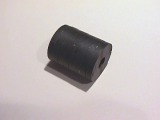
Having a stack of magnets will produce a large, stray field.
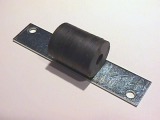
Placing a stack of magnets onto a steel bar or plate helps contain some of the field.
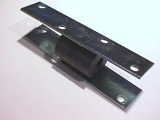
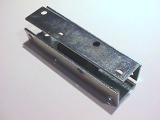
Placing 2, 3 or 4 steel bars around the stack of magnets does a good job of containing the magnetic field.
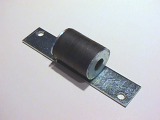
Sticking steel end pieces onto the stack of magnets further directs the field into the bar and not allow it to stray.
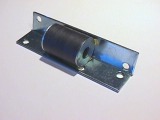
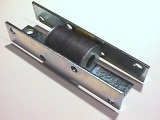

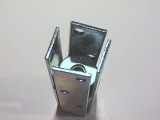
Sticking multiple bars around the magnets, with steel end pieces, takes this a step further. There is very little stray field with this arrangement.
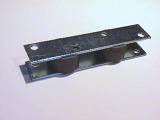
Place half the stack of magnets onto a steel plate, and place the other half, turned around, onto the same plate, and add a second plate on top. So, each plate is seeing a North pole from one stack and a South pole from the other stack. The steel plate is acting like a low resistance path for the magnetic field to from one stack to the other. Think of this as shorting out the magnet - but this does not damage the magnet in any way!
Placing any of the above into a steel container will prevent the field from going outside the steel container. This can be something like a paint can or soup can.
The best you can do is to place the magnets into a thick, steel container with space between the magnets and the inside walls.
When shipping magnets, the field outside the
shipping carton needs to be below a certain level. This is often achieved
by:
1. wrapping the magnet(s) in foam
2. placing it in a plastic bag
3. placing the bag into a steel can with foam between the bag
and the inside walls of the can
4. placing the can into a cardboard box with styrofoam packing
surrounding the can to keep it in the middle of the box
If you build the gaussmeter I describe, you can check to see how weak the field outside the box is. Make this an experiment to determine the most cost effective solution to achieving a method of storing magnets with very low stray fields.
To goal is to contain the field. The best way to do this is to provide an easy path for the magnetic field to go from the North pole to the South pole. If you do that, the field won't want to go anywhere else! You direct it where you want it.
(Thanks to www.oemagnet.com and www.magnets-china.com for some of the photos)